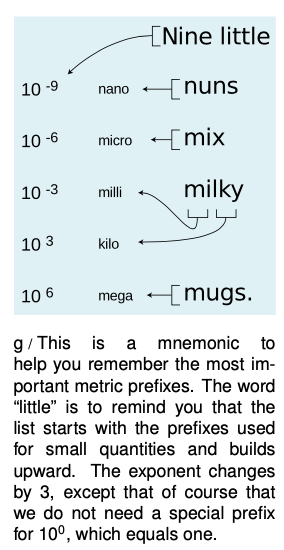LM 0.07 Less common metric prefixes Collection
Tags | |
UUID | 1e3581aa-f145-11e9-8682-bc764e2038f2 |
0.7 Less common metric prefixes by Benjamin Crowell, Light and Matter licensed under the Creative Commons Attribution-ShareAlike license.
0.7 Less common metric prefixes
The following are three metric prefixes which, while less common than the ones discussed previously, are well worth memorizing.
| prefix | meaning | example |
| mega- M | 106 | 6.4 Mm = radius of the earth |
| micro- μ | 10-6 | 10μm = size of a white blood cell |
| nano- n | 10-9 | 0.154 nm = distance between carbon nuclei in an ethane molecule |
Note that the abbreviation for micro is the Greek letter mu, μ - a common mistake is to confuse it with m (milli) or M (mega).
There are other prefixes even less common, used for extremely large and small quantities. For instance, 1 femtometer= 10-15 m is a convenient unit of distance in nuclear physics, and 1 gigabyte= bytes is used for computers' hard disks.  The international committee that makes decisions about the SI has recently even added some new prefixes that sound like jokes, e.g., 1 yoctogram= 10-24 g is about half the mass of a proton. In the immediate future, however, you're unlikely to see prefixes like “yocto-” and “zepto-” used except perhaps in trivia contests at science-fiction conventions or other geekfests.
The international committee that makes decisions about the SI has recently even added some new prefixes that sound like jokes, e.g., 1 yoctogram= 10-24 g is about half the mass of a proton. In the immediate future, however, you're unlikely to see prefixes like “yocto-” and “zepto-” used except perhaps in trivia contests at science-fiction conventions or other geekfests.
self-check: Suppose you could slow down time so that according to your perception, a beam of light would move across a room at the speed of a slow walk. If you perceived a nanosecond as if it was a second, how would you perceive a microsecond?
(answer in the back of the PDF version of the book)
0.7 Less common metric prefixes by Benjamin Crowell, Light and Matter licensed under the Creative Commons Attribution-ShareAlike license.
Equations
- Length MichaelBartmess Use Equation
- Comments
- Attachments
- Stats
No comments |
